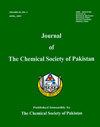基于气相色谱-质谱的沙特阿拉伯芥菜叶片植物化学分析及体外抗脂质过氧化、环加氧酶抑制活性
IF 0.5
4区 化学
Q4 CHEMISTRY, MULTIDISCIPLINARY
Journal of the chemical society of pakistan
Pub Date : 2022-01-01
DOI:10.52568/001001/jcsp/44.02.2022
引用次数: 0
摘要
芥蓝是沙特阿拉伯一种有益健康的一年生灌木草本植物。芥菜的叶子是一种传统的食物,可以在沙拉中生吃。本研究报道了沙乌地阿拉伯芥叶水煎液的植物化学分析、体外抗脂质过氧化、总抗氧化能力、环氧化酶-1和-2 (COX1和COX2)抑制活性。经气相色谱-质谱联用(GC-MS)分析,发现了6个不同化学基团的17种成分:酚类(23.60%)、芳香族和脂肪族酯(16.97%)、萜类(31.91%)、杂环类(14.83%)、含硫有机物(11.25%)和硅基化合物(1.44%)。其中虾青素(1.96%)、甾烷甾醇(12.81%)、Ingol-12-acetate(4.77%)和叶绿醇(12.37%)的含量表明,该方法可有效提取耐热萜类化合物。本研究首次报道了芥蓝的耐热性植物化学物质。EWD与150 ~ 400 μg/ml浓度呈直线关系。EWD与槲皮素的抗脂质过氧化作用有统计学意义。最高剂量400 μg/ml时,EWD值为68.46,#177;0.01%抗脂质过氧化活性。edd和抗坏血酸对总抗氧化能力的IC50分别为217.90和74.91 μg/ml。体外实验方案描述了芥蓝对生物氧化过程的抑制模式,表明氢离子和金属离子的转移还原。采用Ellmannand试剂筛选COX抑制电位。对COX1和COX2的IC50值分别为152.31μg/ml和146.4 μg/ml,表明与吲哚美辛相比,EWD具有较强的COX抑制潜力。COX2/COX1的抑制比小于1,表明EWD植物化学物质可能是COX2的优先抑制剂。本研究通过确定红花叶水煎液中具有抗氧化和抑制COX活性的化学成分,证明了红花叶是一种有益的保健食品。本文章由计算机程序翻译,如有差异,请以英文原文为准。
Gas Chromatography-Mass Spectrometry-based Phytochemical Analysis and In-Vitro Anti-Lipid Peroxidation, Cyclooxygenase Inhibition Activities of Saudi Eruca sativa Leaves
Eruca sativa is a wholesome yearly shrubbery herb in Saudi Arabia. Eruca sativa leaves are a conventional food and are consumed raw in salads. The present research reports the phytochemical analysis, in-vitro anti-lipid peroxidation, total anti-oxidant capability, cyclooxygenase-1, and -2 (COX1 and COX2) inhibition activities of Saudi Eruca sativa leaves water decoction (EWD). Gas chromatography-mass spectrometry (GC-MS) of EWD revealed seventeen constituents of six different chemical groups: phenolics (23.60%), aromatic and aliphatic esters (16.97%), terpenoids (31.91%), heterocyclics (14.83%), sulfur containing organics (11.25%), and silyl compounds (1.44%). The presence of Astaxanthin (1.96%), Clionasterol (12.81%), Ingol-12-acetate (4.77%), and Phytol (12.37%) in EWD indicated that the decoction technique was effective in extracting thermostable terpenoids. This research is the first report on Eruca sativa unraveling the thermostable phytochemicals. The EWD exhibited a straight-line relationship between liver lipid peroxidation inhibition and 150 to 400 μg/ml concentrations. The % anti-lipid peroxidation effect produced by EWD and Quercetin was statistically significant. At the highest 400 μg/ml dose, EWD exhibits 68.46 and#177; 0.01% anti-lipid peroxidation activity. The demonstrated IC50 of EWD and Ascorbic acid concerning the total anti-oxidant capability is 217.90 μg/ml and 74.91 μg/ml. The in-vitro assay protocols delineated the modes of inhibition of the biological oxidation processes by Eruca sativa, indicating transfer of hydrogen ion and metal ions reduction. The COX inhibitory potential was screened using Ellmannand#39;s reagent. The IC50 values for COX1 and COX2 inhibitions were 152.31μg/ml and 146.4 μg/ml, respectively, indicating that EWD has a potent COX inhibitory potential compared to Indomethacin. The COX2/COX1 ratio of inhibition, less than one, suggested that EWD phytochemicals would be preferential inhibitors of COX2. The current investigation justifies Eruca sativa leaves as a beneficial health food by establishing the chemical composition of water decoction that contributed to the anti-oxidant and COX inhibition activity.
求助全文
通过发布文献求助,成功后即可免费获取论文全文。
去求助
来源期刊
CiteScore
1.30
自引率
14.30%
发文量
41
审稿时长
3.4 months
期刊介绍:
This journal covers different research areas in the field of Chemistry. These include; Analytical Chemistry, Applied Chemistry, Biochemistry, Environmental Chemistry, Industrial Chemistry, Inorganic Chemistry, Organic Chemistry and Physical Chemistry. The journal publishes full length articles and Reviews from researchers in academia in addition to featuring comments. Chemical Research presents short, concise and critical articles offering easy-to-read overviews of basic research and applications in all areas of chemistry.

 求助内容:
求助内容: 应助结果提醒方式:
应助结果提醒方式:


